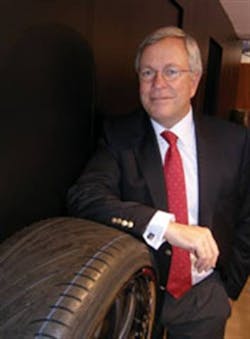Dutch tiremaker Vredestein Banden B.V. has a lot of money riding on its theory that European and American tire buyers are looking for the same things.
The company -- which operates Vredestein Tyre North America Inc. out of Metuchen, N.J. -- maintains the traditional European position that consumers need one set of tires for winter driving and another set for the warmer months.
And it continues to promote its partnership with Italian industrial design house Giugiaro Design, which might impress fashion-conscious consumers in Paris, but may arguably not mean as much in Minneapolis or Charleston.
Modern Tire Dealer recently caught up with Vredestein CEO Robert Oudshoorn to discuss the company's plans for the U.S. market in 2007, how European and American tire trends influence one another, and whether Vredestein dealers in the U.S. have been able to sell the Giugiaro design concept.
[PAGEBREAK]
MTD: What is Vredestein planning for the U.S. market this year?
Oudshoorn: In the North American market we were pretty much a winter tire specialist. Many more sizes for the Ultrac Sessanta, which is a tire for the summer market, are out already. We'll also bring out a new four-season tire in the fall.
MTD: For many years in the United States, tire manufacturers told consumers that all-season tires were all that they needed for year-round use. In Europe, you have winter tires and summer tires. Will that concept catch on again in the U.S.?
Oudshoorn: In Germany, there is a new regulation that obliges you to fit winter tires in winter. And it's not only for German drivers; it's for people from other countries who travel in Germany. I don't think that will ever happen (in America), but it should happen. If you look at the winter season in the north of the U.S. and how fierce it can be, it's downright dangerous. But from what I see, (dedicated winter tires) are still more for people who have money.
MTD: What are some of the differences you see between the European market and the U.S. market?
Oudshoorn: In terms of tires and wheels, everything is bigger in the U.S. Another thing is that in Europe if you buy a Ferrari, you know its wheels are designed for that car and you leave them on until you sell the car. In the U.S., the first thing you do after you buy a car is change the wheels.
MTD: What trends in Europe are influencing the U.S. market?
Oudshoorn: In Europe we have strict laws about the speed index. The trend at the moment is W- and Y-rated tires and they are fit for cars that really make those speeds. In the states, I often hear dealers say, 'Our customers don't care about speed ratings because they never go faster than 60 miles per hour.' And that's something I detest. First of all, it's not true. If you brake full speed at 60 mph with bad tires, you can go five car lengths longer than with good tires.
[PAGEBREAK]
MTD: Do you think the designer tire concept translates to the American market? Have your dealers been able to sell it?
Oudshoorn: We've been working with Giugiaro for 10 years and it took a while in Europe before dealers started to understand that we are serious about this. Giugiaro Design is well-known in Europe, but I think it's lesser known in the U.S. But in any case, wherever we sell our tires, we stress Giugiaro. Every high performance tire we bring out is linked together with Giugiaro.
"I know how it works as a tire dealer," says Oudshoorn. "There's no consumer who says he needs a designer tire. But if you're a tire dealer and you can say, 'I have something very special,' it could close the deal. It's that little extra."



